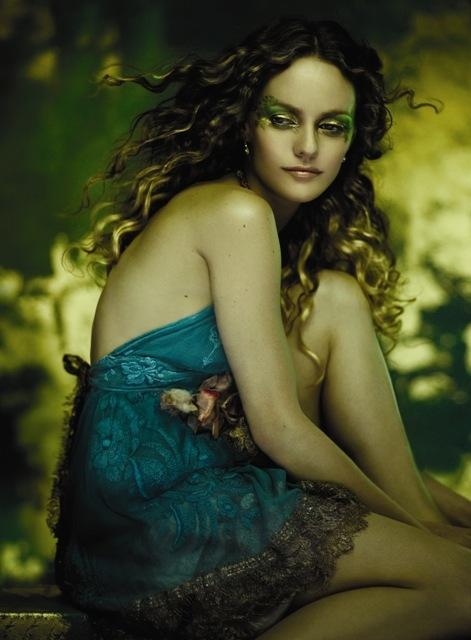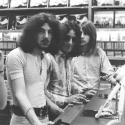Vanessa Paradis is a card-carrying icon, but for us Brits the reason why is hard to define. After the hyper-cute “Joe le taxi” hit the charts in 1987 when she was 14, Paradis didn’t carve a musical career here. Being the partner of Johnny Depp is her usual route into the press. As an actress, she attracts attention when her films get a British release. Last night was a rare chance to see whether her music could stand on its own, and make her more than a cipher.
In France, she’s not wildly prolific musically: she’s issued 10 albums, the first in 1988. But four were live sets and one a best-of. There's some good records. Others are great, but there's a lot of piffle too. Her most recent was the spiffy – again live – Une Nuit à Versailles, issued in France just before Christmas. An orchestrated, acoustic-slanted run-through of her best-known cuts, it was a stocking-filling smash. Last night’s show had been billed as a greatest-hits set, implying it would look back to 2009’s Best of collection, but it was actually pretty much the Une Nuit à Versailles show, string quartet, stage layout and all.
The continual reconfiguring of the limited musical building blocks is in keeping with Paradis’s amorphousness. Like so many French singers, she isn’t about one thing. Serge Gainsbourg, who composed for her and she performed with, also acted and wrote for the stage. Sylvie Vartan and Françoise Hardy both turned up in films in the Sixties. Johnny Hallyday and Jacques Dutronc also act. The traffic goes the other way, actors sing: Charlotte Gainsbourg, Julie Delpy, Sandrine Kiberlaine, Catherine Deneuve and Isabelle Adjani (the latter two with Serge Gainsbourg). Models do too – see Carla Bruni. But Paradis blurs boundaries more than most. Singing on TV from age nine, she’s also modelled clothes - she began her ongoing relationship with Chanel 10 years later. But music is what she’s been at longest and, despite thoughts of what she is or isn’t being hard to force to the back of your mind, that’s what tonight’s about.
Even so, a fair amount of heads in the crowd were waggling. They were probably hoping Depp was here. Tongues were wagging too. Despite a woman coming onstage before Paradis to announce that this would be a quiet show and asking for talking to be confined to the bar, an ever-audible portion of the crowd just couldn’t stop yakking.
As if that wasn’t distracting enough, the venue itself is hardly conducive to reflective recastings of the Paradis oeuvre. The red and gold décor is beautiful. The chandeliers are lovely. But this sold-out, standing-only venue has terrible sightlines. Unless you’re at the edge of a balcony or close to the stage, it's mostly impossible to see anything. A Cadogan Hall or a Queen Elizabeth Hall would have been more sympathetic.
Vanessa Paradis performs "St Germain" from Une Nuit à Versailles
Casually chic, Paradis was in jeans and a top strewn with hanging beads. Her hair was Pre-Raphaelite. Her make-up could have come from a painter's brush. Sporting trademark red Chanel lipstick, she was a doll; Serge Gainsbourg’s “Poupée de Cire, Poupée de Son”. With little that’s spontaneous in her stage persona, it was like watching TV. Not that it mattered for this seven-eighths French - and hugely partial - audience. People said "Pardon" when they bumped into you. More wine was going across the bar than beer. Having grown up with Paradis as a soundtrack to their lives, this was an event. Yet still, there was that ever-present chit-chat. A must-see event, but perhaps one that’s not about the actual content?
The set list was mostly familiar. The opening takes of “Pourtant” and “Que fait la vie” were sensitive, with the strings matching Paradis’s voice well. Such lovely moments contrasted sharply with the forced peppiness of the Sixties-sounding "Sunday Mondays", written for her by former paramour Lenny Kravitz. A version of Françoise Hardy’s “Le temps de l’amour” worked – again due to its softness. The downbeat acoustic reconfiguring of “Joe le taxi” sent the audience bananas and was equally fine. But what’s the point of yet another cover of Leonard Cohen’s “Hallelujah”? “What a Wonderful World” was equally pointless. Too many bases were covered. Last night, though, was about the presence of Vanessa Paradis herself, and that was probably enough. But only if you engage with her as more than a singer, as a symbolic being. And in that sense, she actually is unreal. She needs to be seen on a screen, heard through a speaker, kept at a remove. Not seen on a stage in Camden.
- Find The Best of Vanessa Paradis on Amazon















Add comment